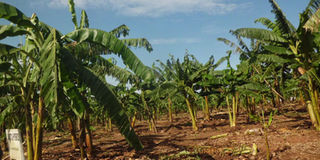Scientists tip on better banana yields

Experts say plant spacing is 3cm by 3cm. This enables the plants to yield better . PHOTO BY LOMINDA AFEDRARU
What you need to know:
- BOUNTY HARVEST. Improve your banana yields by engaging in better agronomy methods as Lominda Afedraru explores.
Banana production in Uganda has been constrained by pests, diseases, soil fertility decline and most recently climate change. Farmers manage these challenges through agricultural practices. Such are not practiced by majority of the farmers growing banana in Uganda.
However, scientists at National Agricultural Research Laboratories (NARL) are embarking on taking farmers through the key agronomy practices to improve their yields.
Challenges including diseases such as banana bacterial wilt, fusarium wilt, black sigatoka and nematode pest cause decline in banana production. This is being addressed by breeding improved varieties such as growing Kabana 6H known as M9 and M2 with resistance to black sigatoka and tolerant to nematodes and weevils. The food scientists working under a five-year project which was launched in Kampala recently are set to sensitise farmers in various banana growing regions in Uganda and Tanzania about best agronomy practices.
Recommended practices
Dr Kenneth Akankwasa from NARL, takes us through the good agronomy practices.
• When preparing the field, farmers are expected to plant seedlings free of pests and disease.
• The site should have deep well-drained and fertile soils, preferably rich in organic matter because it will enable the roots of the plants to be stable and to tolerate infections.
• Newly opened land without signs, history of nematodes or the devastating fusarium wilt and bacterial wilt diseases is preferred.
• If the site has been used for production of bananas where infections have occurred, it is highly recommended to remove all remaining plants and corms. Also, proper sanitation in the field and eliminating infected plants.
• Mulching, just like digging trenches is important for conserving water for the plant.
• Other practices include pruning the unwanted dry leaves and farmers are not encouraged to dig under the plantation but maintain no- till technology by weeding on the surface to avoid destruction of the root system of the plants.
• Application of fertiliser in soil preparation is important for boosting soil nutrients. This leads to quality yield of banana bunches weighing 70kg to 80kg. A farmer who applies fertiliser in his field is capable of keeping the plantation above 50 years without replanting.
• Planting materials should be prepared in the field from where they are being obtained to limit the transfer of infections into new fields.
• Remove outer leaf sheaths, dead roots of the plant and trim part of the corm to eliminate weevils and nematodes. Any brown and black spots that may appear on the corms should be removed until only white corm tissue remains.
• Remove the male buds early to help reduce the spread of diseases such as banana bacterial wilt, which can be transmitted by bees collecting nectar from the banana male buds.
• Maintain 1,000 plants on one hectare. To get bigger bunches, avoid crowding.
The benefits
Dr Jerome Kubiriba, head of banana programme at NARL, explains that the importance of banana farmers observing best practices for improved yield notes that the current status of banana production on farm on average is 10 tonnes per hectare per year and at research stations is 60 tonnes per hectare per year.
“Statistics show that farmers who pay less attention to good practices produce five tonnes of bananas per hectare per year while those keen in best practices produce up to 40 tonnes per hectare per year”
Aim of the sensitisation
In Uganda the selected sites targeting 5,000 farmers in each site include Nakaseke in central Uganda, Rwimi in Fort Portal and in Mbarara. In Tanzania, it shall be Arusha and Bukoba: “The scientists expect to engage more than 25,000 farmers by the end of the exercise and improve banana productivity from 10 bunches in one hectare to 25 bunches,” Dr Kubiriba explains.




